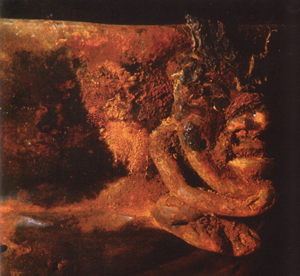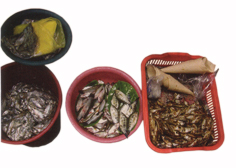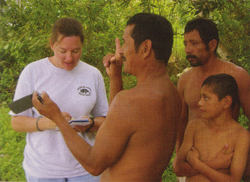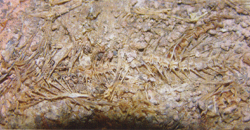
In 426 AD, a noble we now know as K’inich Yax K’uk’ Mo’ (Great Sun First Quetzal Macaw), arrived in the Copán Valley of Honduras, Central America, and founded a dynasty of Maya kings that endured for over 400 years. Where Yax Ku’k Mo originally traveled from is still a mystery, but we have learned that the woman he chose to govern by his side was the daughter of a local ruler, and that she became one of the most powerful women in the realm. Her son, Yax Ku’k Mo’s successor, buried her in a fabulous tomb (the richest woman’s tomb so far discovered in the Maya world) with treasure from across the kingdom, including fascinating shells and animal remains. The queen’s tomb (called the Margarita Tomb) was found buried deep in the heart of the vast acropolis of the site of Copan by members of the Early Classic Copan Acropolis Project research team from the University of Pennsylvania, led by Robert Sharer. Between 1989 and 2001 the team also recovered other caches and offering deposits in the Copán Acropolis, all of them rich in symbolic meaning, and many of them containing animal remains that needed expert identification.

Following a request from the Pennsylvania team for my assistance in providing those identifications, in the summer of 2004, I traveled with Florida Museum of Natural History Collection Manager Irvy Quitmyer and University of Florida Ph.D. candidate Erin Thornton to the site of Copán to identify and analyze the animal remains included in the Margarita Tomb and other Early Classic ritual deposits from the central Acropolis of the site. Since that summer in the Florida Museum Environmental Archaeology Program laboratory, we have examined more than 700 artifacts and other remains from the Margarita structure, including remains from the tomb of the founding mother, and from a fascinating adjacent offering called the Margarita Mercury Cache.
Among the burial goods interred in the Margarita Tomb, the most exciting for us were a collection of ceramic vessels containing the remains of a final feast, perhaps designed to travel with the first queen of Copán to the afterlife, or as a gift to the gods. Although such vessels are often found in Maya tombs, the contents are rarely preserved. In the Margarita Tomb, the vessels were found with the remains of tiny fish and shrimp, so well preserved that the shape of each animal was still visible! To accurately identify the tiny fish and shrimp in the vessels, we visited the local markets and went fishing with the local fishermen, gathering examples of the various species and skeletonizing them to compare with the archaeological remains. The results were intriguing.

The final meal of the queen included not the largest and meatiest favorites of the commoners, but the tiny delicate riverine minnows, cichlids, and clupeid fishes, and the seasonal estuarine/riverine palaemonid shrimps still eaten today as a delicacy at family festivals. Even more intriguing is the fact that our research indicates the shrimp were served whole, with heads intact, and, according to research by New York University graduate student Cameron McNeil, the fish were served in a chocolate sauce!
The Margarita Mercury Cache also contained animal remains important for their symbolic meaning and our understanding of ritual foods associated with death and rebirth. The Mercury Cache is so named because it contained 300 ml of liquid mercury as part of a complicated layered offering that symbolically mimicked the many layers of the Maya cosmos. The cache included three vessels, one of which was inverted as a lid sealing a second vessel, the front of which was decorated by a mysterious seated character, wearing a mask. This vessel contained a complete female ocellated turkey accompanied by a second, decapitated turkey head. The double-headed bird is an important emblem for the Maya still today! Inside the turkey’s body cavity were nine white quartz stones too large to be natural gizzard stones (nine is a sacred number for the Maya). Scattered around the vessels as part of the cache were the remains of two species of turtle, a fish, and a second turkey (the original owner of the second head in the vessel perhaps). Offerings of male and female fowl are still a part of Maya ritual today. The entire assemblage had been completely burned in situ, possibly as part of the “consuming” process of a ritualized feast prepared for the gods.

Zooarchaeologists, scientists investigating animal remains recovered from archaeological sites, tend to spend much of their time identifying the garbage tossed away by the ancients. Working in the garbage heaps of the ancient Maya for the last 20 years, I have learned a lot about the favored foods of the rich and poor of this marvelous civilization, famous for its mysterious temples in the jungles of Central America. Work in the ritual deposits of the Copán Acropolis has, however, given me a new opportunity to compare the daily or secular use of animals to their role in elite Maya ritual and symbol.
For more information on the excavations at Copan, Honduras and on the finds of the Margarita Tomb, please see:
Bell, E. E., R. J. Sharer, D. W. Sedat, M. A. Canuto and L. A. Grant. 2000 The Margarita tomb at Copan, Honduras: A research update. Expedition 42(3):21-25.
Bell, E.E., M.A. Canuto and R.J. Sharer. 2004. Understanding Early Classic Copan. Oxbow books.
Sharer, R. J., J. C. Miller and L. P. Traxler. 1992. Evolution of Classic Period Architecture in the Eastern Acropolis, Copan. Ancient Mesoamerica 3:145-159.
Sharer, R. J., L. P. Traxler, D. W. Sedat, E. E. Bell, M. A. Canuto and C. Powell. 1999. Early Classic Architecture Beneath the Copan Acropolis. Ancient Mesoamerica 10:3-23.
This research project was funded by the Foundation for the Advancement of Mesoamerican Studies Inc. My other projects on the animals of the ancient Maya are funded by granting institutions such as the Heinz Family Foundation, the FAO Schwarz Family Foundation and donations from readers.
Learn more about the Environmental Archaeology Collection at the Florida Museum.